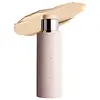What's inside
What's inside
 Key Ingredients
Key Ingredients

 Benefits
Benefits

 Concerns
Concerns

 Ingredients Side-by-side
Ingredients Side-by-side

Water
Skin ConditioningDimethicone
EmollientMethyl Trimethicone
Skin ConditioningTrimethylsiloxysilicate
EmollientDiphenyl Dimethicone/Vinyl Diphenyl Dimethicone/Silsesquioxane Crosspolymer
Propanediol
SolventPEG-10 Dimethicone
Skin ConditioningSilica
AbrasiveGlycerin
HumectantButylene Glycol
HumectantMica
Cosmetic ColorantPhenoxyethanol
PreservativeDisteardimonium Hectorite
StabilisingDimethicone/Vinyl Dimethicone Crosspolymer
Skin ConditioningBambusa Arundinacea Stem Extract
Skin ConditioningSodium Chloride
MaskingSorbitan Sesquiisostearate
EmulsifyingHydrogenated Lecithin
EmulsifyingEthylhexylglycerin
Skin ConditioningTitanium Dioxide
Cosmetic ColorantCaesalpinia Spinosa Fruit Extract
Skin ProtectingTropaeolum Majus Flower/Leaf/Stem Extract
Skin ConditioningTriethoxycaprylylsilane
Alumina
AbrasiveMagnesium Oxide
AbsorbentKappaphycus Alvarezii Extract
Skin ConditioningMethicone
EmollientCamellia Sinensis Leaf Extract
AntimicrobialIron Oxides
Water, Dimethicone, Methyl Trimethicone, Trimethylsiloxysilicate, Diphenyl Dimethicone/Vinyl Diphenyl Dimethicone/Silsesquioxane Crosspolymer, Propanediol, PEG-10 Dimethicone, Silica, Glycerin, Butylene Glycol, Mica, Phenoxyethanol, Disteardimonium Hectorite, Dimethicone/Vinyl Dimethicone Crosspolymer, Bambusa Arundinacea Stem Extract, Sodium Chloride, Sorbitan Sesquiisostearate, Hydrogenated Lecithin, Ethylhexylglycerin, Titanium Dioxide, Caesalpinia Spinosa Fruit Extract, Tropaeolum Majus Flower/Leaf/Stem Extract, Triethoxycaprylylsilane, Alumina, Magnesium Oxide, Kappaphycus Alvarezii Extract, Methicone, Camellia Sinensis Leaf Extract, Iron Oxides
Caprylic/Capric Triglyceride
MaskingIsononyl Isononanoate
EmollientIsodecyl Neopentanoate
EmollientDicalcium Phosphate
AbrasiveMicrocrystalline Wax
Emulsion StabilisingSqualane
EmollientPolyethylene
AbrasiveVp/Hexadecene Copolymer
Synthetic Wax
AbrasiveDisteardimonium Hectorite
StabilisingHydrogenated Polyisobutene
EmollientSilica
AbrasiveNylon-12
Camellia Oleifera Seed Oil
Skin ConditioningHydrogenated Coconut Oil
EmollientPhytosphingosine
Skin ConditioningButyl Stearate
EmollientIsostearyl Alcohol
EmollientAlcohol
AntimicrobialWater
Skin ConditioningPentaerythrityl Tetra-Di-T-Butyl Hydroxyhydrocinnamate
AntioxidantButylene/Ethylene/Styrene Copolymer
Ethylene/Propylene/Styrene Copolymer
Mica
Cosmetic ColorantDibutyl Lauroyl Glutamide
Skin ConditioningRubus Idaeus Leaf Cell Culture
Skin ConditioningTin Oxide
AbrasiveCaprylic/Capric Triglyceride, Isononyl Isononanoate, Isodecyl Neopentanoate, Dicalcium Phosphate, Microcrystalline Wax, Squalane, Polyethylene, Vp/Hexadecene Copolymer, Synthetic Wax, Disteardimonium Hectorite, Hydrogenated Polyisobutene, Silica, Nylon-12, Camellia Oleifera Seed Oil, Hydrogenated Coconut Oil, Phytosphingosine, Butyl Stearate, Isostearyl Alcohol, Alcohol, Water, Pentaerythrityl Tetra-Di-T-Butyl Hydroxyhydrocinnamate, Butylene/Ethylene/Styrene Copolymer, Ethylene/Propylene/Styrene Copolymer, Mica, Dibutyl Lauroyl Glutamide, Rubus Idaeus Leaf Cell Culture, Tin Oxide
 Reviews
Reviews

Ingredients Explained
These ingredients are found in both products.
Ingredients higher up in an ingredient list are typically present in a larger amount.
Disteardimonium Hectorite comes from the clay mineral named hectorite. It is used to add thickness to a product.
It can also help stabilize a product by helping to disperse other ingredients.
Hectorite is a rare, white clay mineral.
Learn more about Disteardimonium HectoriteMica is a naturally occurring mineral used to add shimmer and color in cosmetics. It can also help improve the texture of a product or give it an opaque, white/silver color.
Serecite is the name for very fine but ragged grains of mica.
This ingredient is often coated with metal oxides like titanium dioxide. Trace amounts of heavy metals may be found in mica, but these metals are not harmful in our personal products.
Mica has been used since prehistoric times throughout the world. Ancient Egyptian, Indian, Greek, Roman, Aztec, and Chinese civilizations have used mica.
Learn more about MicaSilica, also known as silicon dioxide, is a naturally occurring mineral. It is used as a fine, spherical, and porous powder in cosmetics.
Though it has exfoliant properties, the function of silica varies depending on the product.
The unique structure of silica enhances the spreadability and adds smoothness, making it a great texture enhancer.
It is also used as an active carrier, emulsifier, and mattifier due to its ability to absorb excess oil.
In some products, tiny microneedles called spicules are made from silica or hydrolyzed sponge. When you rub them in, they lightly polish away dead skin layers and enhance the penetration of active ingredients.
Learn more about SilicaWater. It's the most common cosmetic ingredient of all. You'll usually see it at the top of ingredient lists, meaning that it makes up the largest part of the product.
So why is it so popular? Water most often acts as a solvent - this means that it helps dissolve other ingredients into the formulation.
You'll also recognize water as that liquid we all need to stay alive. If you see this, drink a glass of water. Stay hydrated!
Learn more about Water